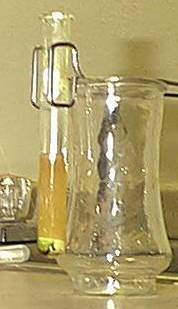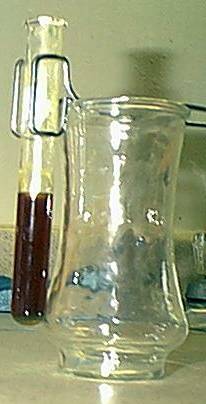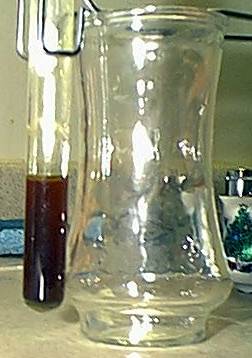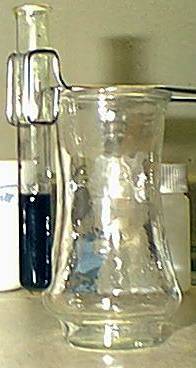| Pages:
1
2 |
hodges
National Hazard
   
Posts: 525
Registered: 17-12-2003
Location: Midwest
Member Is Offline
|
|
Reaction Notes
I tried this today, on a small scale.
Here is a test tube of NaOH with some sulfur dissolved in it:

After heating this solution, it looked like this:

When allowed to cool after heating, it didn't look much different (I removed a small amount of the solution for another test):

After adding a small ball of aluminum foil and allowing the reaction to complete, here was the result (note that some of the solution was
consumed/vaproized):

When adding dilute HCl to the NaOH/S solution that had been previously heated,
sulfur precipitated and a (very small) amount of H2S was noted. When adding dilute HCl to the final product, vigorous bubbling of H2S was observed.
I'm thinking the dark green / black product is Al2S3, in NaOH solution. Adding HCl neutralizes the NaOH (at least locally), allowing the Al2S3
to react with water to produce H2S. But is Al2S3 green?
|
|
|
Theoretic
National Hazard
   
Posts: 776
Registered: 17-6-2003
Location: London, the Land of Sun, Summer and Snow
Member Is Offline
Mood: eating the souls of dust mites
|
|
Al2S3 reacts with any water there is, high pH is not a hindrance.
|
|
|
chemoleo
Biochemicus Energeticus
    
Posts: 3005
Registered: 23-7-2003
Location: England Germany
Member Is Offline
Mood: crystalline
|
|
Once you added the Al foil, did you dilute the solution with dH2O? If not, try that. I bet you get the same thing as I did...
and still I am not any closer to the mystery of what this black precipitating stuff is!
Edit: Make sure you add Al until saturation! You can in fact add quite a lot!
[Edited on 15-2-2004 by chemoleo]
Never Stop to Begin, and Never Begin to Stop...
Tolerance is good. But not with the intolerant! (Wilhelm Busch)
|
|
|
chemoleo
Biochemicus Energeticus
    
Posts: 3005
Registered: 23-7-2003
Location: England Germany
Member Is Offline
Mood: crystalline
|
|
Well, remember this experiment?
NaOH + S + heat --> (Na)ySx ?
Then (Na)ySx + Al --> ???
Well, have a look at picture No 5 from my last post. You wil see a black precipitate. Strangely enough, now, after 5 months, it has turned
orange-brown, and it looks deceptively like some iron oxido hydrate. Rusty colour. I honestly dont know what to think of it. The Aluminium I used was
pure, delivered from Merck, of analytical quality. The NaOH was pure too. The sulphur - well there may have been some antimony, or whatever... but I
doubt it would be more than one percent.
What do you think?
Unionised? (you may have to re-read the thread to afford a judgement  ) )
Seriously, this whole thing baffles me.
I dissolve sulphur in hot NaOH (aq), which forms a red solution. To this I add Al (pure, not foil). This yields initially a dark green
solution/suspension (upon dissolution with destilled water), and then, a black preicipate. After a few months, this preciptitate takes on a rusty
orange-brown-red colour.
All I can say is - these were clean reagents to my knowledge. What happened???
Why has it taken on this rusty colour? I'd think oxidation of course. Iron would be a candiate. But where would it come from, if these are
analytical grade compounds?
Could it be some kind of polysulphide?
Chemistry is indeed a mystery at times! I am not sure whether to trust my reagents anymore 
Never Stop to Begin, and Never Begin to Stop...
Tolerance is good. But not with the intolerant! (Wilhelm Busch)
|
|
|
Theoretic
National Hazard
   
Posts: 776
Registered: 17-6-2003
Location: London, the Land of Sun, Summer and Snow
Member Is Offline
Mood: eating the souls of dust mites
|
|
Maybe the thioaluminate ion AlS2- is formed? Or something else with Al-S bonds?
|
|
|
chemoleo
Biochemicus Energeticus
    
Posts: 3005
Registered: 23-7-2003
Location: England Germany
Member Is Offline
Mood: crystalline
|
|
And you wouldnt have more info on this? thioaluminates... but why the colour change? Or this precipitating behaviour upon dilution with H2O?
Never Stop to Begin, and Never Begin to Stop...
Tolerance is good. But not with the intolerant! (Wilhelm Busch)
|
|
|
unionised
International Hazard
    
Posts: 5126
Registered: 1-11-2003
Location: UK
Member Is Offline
Mood: No Mood
|
|
Have you the equipment/ reagents to test the rusty lookig stuff t see if it's iron based?
Even the pink colour with salicylate would be a strong hint (just in case you don't have ICP/MS kit lying around in your garage) 
|
|
|
Polverone
Now celebrating 21 years of madness
        
Posts: 3186
Registered: 19-5-2002
Location: The Sunny Pacific Northwest
Member Is Offline
Mood: Waiting for spring
|
|
the mysterious "green from sulfur" revisited
I made some sodium polysulfides by mixing a small amount of water, photo-grade Na2S, and agricultural sulfur together in a narrow-necked glass bottle.
Since I wanted to see how heat/light/air degraded the mixture, I plugged the top of the bottle with a cotton ball (to keep insects/debris out) and
left it outside where it would be exposed to sun. It took about a week for most of the sulfur to dissolve. There was always some cloudiness left that
I think may have been from non-sulfur components of the agricultural dusting sulfur. After more than a month of heat, light, and air, the solution had
changed from the rich, deep polysulfide color to a weak yellow/green (mostly yellow). After several days of yellow/green color, I decided it was time
to filter and examine.
I filtered through a plug of cotton. The filtrate was still quite alkaline, though considerably less than when I started. The solution, though it was
still warm from sitting in the sun, had no scent. On addition of phosphoric acid to a portion of the filtrate, the temperature rose, bubbling
commenced, and a precipitate of sulfur formed. I first smelled H2S, followed and overpowered by SO2. So it appears that a considerable amount of
thiosulfate was formed, as I expected.
The now-clear filtrate still has a yellow color and is going back in the cotton-plugged bottle to see if it changes any further.
But - the green stuff! The plug of cotton that I used to filter my liquid was colored a dark green at the top from material it had trapped. The color
struck me as very similar to that produced by reacting aluminum with sulfides. Coincidence?
The green color was destroyed (changed to white/yellow) by the addition of acid.
PGP Key and corresponding e-mail address
|
|
|
Nerro
National Hazard
   
Posts: 596
Registered: 29-9-2004
Location: Netherlands
Member Is Offline
Mood: Whatever...
|
|
I made the green stuff too a while back. I dissolved NaOH untill no more would dissolve and then I added 99.95% pure sulfer powder to the (boiling
hot) solution. It boiled even more vigorously and reacted to form a deepred solution of what presume to have been a NaSx solution. I then added small
pieces of Al (from a pure aluminium pipe) to the solution. They all dissolved so I then put in a 1ft section of the pipe. This partially dissolved
within 6 hours. I removed the bit that remained. The solution had become near-black. But upon dilution and carefull closer inspection it was indeed
(as in the aformentioned cases) green.
Upon addition of H2SO4 (40% solution) to small amount of the green solution a lot of H2S was evolved and a white precipitate of what I presume to be
Al2(SO4)3 or Al(HSO4)3 (probably the former considering the fact that the H2S is removed from the equation as a gas.) was formed.
Also actual green crystals were formed in the solution which indicates a certain amount of stability. The crystals did not seem to react with the air
when they were removed from the solution. The were needle shaped and darkgreen.
NaAlS2 maybe?
[Edited on 9/4/2005 by Nerro]
#261501 +(11351)- [X]
the \"bishop\" came to our church today
he was a fucken impostor
never once moved diagonally
courtesy of bash
|
|
|
mick
Hazard to Others
  
Posts: 338
Registered: 3-10-2003
Member Is Offline
Mood: No Mood
|
|
Back to the original post.
The stuff that melted in the sun could be an emulsion of sulphur and conc NaOH, plastic sulphur, the NaOH stops it from dryng out.
Addition of Al should convert NaSS... SSNa to NaSS..SH.
In a concentrated set up the SH end could pick up some water and adding acid could give H2S and some SO2. I think H2S and SO2 could precipitate
sulphur in the gaseous phase in damp air.
An old container of flaked sodium hydrosulphide has every colour from yellow to pink to green and darker on the surface.
I used to do a lot of poly and hydrosulphide reductions when I was young (sodium and ammonium) but they smell to much now and the waste would be a
problem. They reduced organic disulphide bond well.
Curiosity, has anyone tried using the black residue from dissolving impure Al in NaOH for catalytic hydrogenation. It should have a large surface area
and be fairly active unless it contains a load of carbon, silicon and stuff.
mick
|
|
|
| Pages:
1
2 |